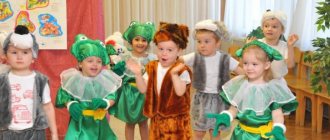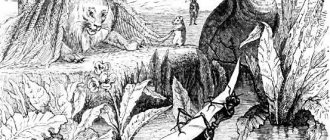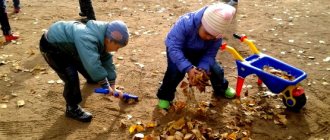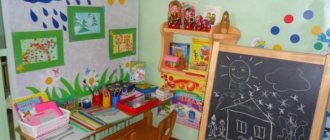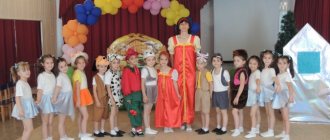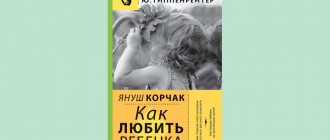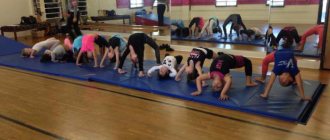Objectives of fiction in the middle group
Preschool institutions devote a special place to reading fiction. Based on the federal state standard, this activity is separated into a separate educational part. She pursues her goals and objectives. These tasks become more complex as the child grows older.
Important! New generations are required to read more than others in order to navigate the flow of information well.
Reading fiction develops thinking and speech
The main purpose of reading to children in the middle group is to develop a comprehensive personality and instill a love of reading. Its tasks are:
- development of experience in listening to works of various genres of folklore (jokes, riddles, fairy tales, etc.), prose (fairy tales and short stories), poetry (poems, fairy tales in verse);
- arousing interest in literary works, instilling a love for constant communication with books with an adult and independently;
- develop the ability to listen and perceive text. The child must understand the main meaning of the text, be able to restore cause-and-effect relationships, be able to characterize the characters of the work, and evaluate their actions;
- develop artistic and speech activity. This is achieved by retelling, expressively telling by heart jokes, poems, nursery rhymes;
- development of skills to compose poetic rhymes and descriptive stories;
- maintaining the child’s desire to express his impressions of the piece he heard. This can be done in the form of a drawing, a game of making figurines.
Children need to be instilled with a love of reading from childhood.
The objectives listed above are educational. In addition to them, there are educational and developmental tasks.
Developmental functions include:
- development of ideas about the natural world;
- speech development based on language norms;
- development of grammatical and lexical skills before the child goes to school;
- development of skills to see beauty.
Among the educational tasks the following stand out:
- formation of ideas about moral standards of behavior;
- formation of positive qualities (kindness, honesty, generosity, etc.);
- the formation of a negative attitude towards bad qualities (lies, envy, etc.).
Reading serves several purposes at once
In the fourth year of life, the child’s perception of fiction is still superficial. He is able to identify only the simplest connections between ongoing events. His attention is focused on one main character and two or three minor ones. He cannot evaluate their actions without understanding the motives for their behavior.
Fiction is perceived differently in the fifth year of life. The child begins to wonder why someone did what they did and what followed. The child is already trying to establish cause-and-effect relationships.
Important! In the fifth year of life, the child begins a different stage of perception of works of art. He shows interest in them and tries to understand the deeper meaning.
Summary of GCD in the middle group of kindergarten. Reading fiction “Wonderful little paws”
Summary of continuous educational activities for the implementation of the educational field “Speech Development” (Reading Fiction) in the middle group of compensatory orientation.
Theme: “Folk culture and traditions.”
Reading the Russian folk tale “Wonderful Lapotochki”. Author: Tatyana Nikolaevna Rogachkova, teacher at MBDOU “Combined Kindergarten No. 15”, Snezhinsk, Chelyabinsk Region. Description of the material: I bring to your attention a summary of direct educational activities for the implementation of the educational field “Speech development” (reading fiction) on the topic “Folk culture and traditions”. This material is suitable for the age category of preschool children 4-5 years old. During the lesson, children learn to listen to fairy tales, draw conclusions based on the content, and continue their acquaintance with antique objects. Goal: to continue introducing children to antiques. Objectives: Educational:
Continue to introduce children to works of oral folk art through reading Russian folk tales.
2. Developmental:
Develop children’s ability to understand the figurative content and idea of a fairy tale, to see the relationship between the content and the title of the work.
3. Educational:
To develop children’s ability to listen to a fairy tale carefully, without interrupting the teacher who is reading.
4. Speech:
Coherent speech: Continue to teach children to answer questions in the text, making grammatically correct sentences.
Vocabulary: subject - little shoes; bast shoes; hut; master; coachman; Daddy, mummy signs - wonderful, deep (river), high (banks); verbal - tired, weaved, carried away. Grammar: activate vocabulary on the topic. Learn to coordinate words in a sentence in gender, number, case, numerals with a noun. Sound culture of speech: develop children's auditory concentration. Methods and techniques:
Practical: Unexpected appearance of bast shoes in a group;
listening to a fairy tale; Visual: looking at pictures of the work. Verbal: Repetition of the title and characters of the fairy tale. Materials:
bast shoes, book, pictures and illustrations for the work.
Individual work:
encourage emotional responses to stories. Preliminary work: examination of encyclopedias, pictures depicting antiques.
Progress of the lesson:
A loud stomp is heard in the group and bast shoes appear from behind the door.
Educator: oh, guys, someone lost their shoes! Whose shoes are these? The children find out that these shoes are not theirs. The teacher invites everyone to sit in a circle and look at the mysterious shoes. Educator: Boys and girls, these are bast shoes. Previously, in the old days, people did not wear sneakers, shoes or boots. And they put on bast shoes. People wove them from straw. And I know a fairy tale about little shoes. Want to listen? Children's answers (yes, we want to listen). The teacher reads a fairy tale. Once upon a time there lived a man, Ivan, in a village. He decided to visit his brother Stepan in a distant village. And the day was hot, the road was dusty. Our Ivan is coming, he’s tired. “I’ll get there,” he thinks, “to the river; I’ll drink some water there and rest.” He comes to the river, and an unfamiliar old man sits on the bank. He took off his bast shoes, put them under a birch tree, sits and has a snack. Ivan drank some water, washed his face, and approached the old man: “Are you going far, grandfather?” - Far away, honey. I'm going to Moscow. Ivan was surprised: “To Moscow?” On foot? Yes, grandpa, you’ll be stomping around for six months! And grandfather answers: “No, honey, not six months.” I wove my own bast shoes. They are not simple, they are wonderful. If I put them on, my feet will run on their own. They sat next to each other and talked; then grandfather lay down under the birch tree and fell asleep. And Ivan thinks: “I wish I had bast shoes like these!” I’ll take off mine and exchange them with my grandfather. In wonderful bast shoes, I can run to my brother in an instant.” He took off his bast shoes, put them under a birch tree, and slowly took his grandfather’s and put on his shoes. As soon as he put on his shoes, our Ivan was picked up, somersaulted in the air, and carried along the road! He runs as fast as he can. He got scared and shouted: “Legs, where are you going?” Stop! And the bast shoes carry him that way. Ivan can't stop. He runs up to the village where his brother lives. This is my brother's house. He flies into the entryway, knocked over the bucket, ran into a broom, and fell onto a pile of dry brooms. Lying down, kicking his legs in the air. “Oh,” he thinks, “trouble. I did something bad, I took someone else’s property without asking. We need to throw off our bast shoes as soon as possible!” He untied the sandals, threw them off his feet, and they stopped. Ivan felt ashamed. “How did I offend grandpa? Oh, not good! If I come back, I’ll give him his bast shoes. Well, now I’ll go to the hut.” He enters the hut, carrying bast shoes in his hands. And in the hut the guests sit and eat at the table. They saw Ivan and laughed: “What are you doing: walking barefoot and carrying sandals in your hands?” Ivan answers: “And these bast shoes, brothers, are too tight for me, my legs hurt.” I took it off. He sat down at the table. And next to him is his neighbor Akim. Akim looked at the little shoes. He thinks: “Eh, these bast shoes would just fit me. Let me exchange with Ivan.” Akim took the wonderful little shoes, put his own in their place, went out onto the porch, sat down and put on his shoes. Just put on my shoes - bang! - carried him down the steps and carried him through the village. He runs and runs, runs and runs, and cannot stop. Akim got scared and shouted: “Good people, catch me!” Stop me! He rushes past his hut. And his sons run out to meet him. The boys stopped by the road, looked at their father, and asked: “Daddy, where did you go?” And Akim shouts: “I’m running home!” And the boys again: “What are you talking about, darling?” The house is over there, but where are you running? Luckily, there was a huge birch tree here. Akim ran up to her, wrapped his arms around her and kept spinning and spinning around her. He shouts to his sons: “Call mommy quickly!” The boys ran home and cried in fear. They shout: “Mama, run outside quickly!” There the little guy has gone crazy - he’s been chasing around the birch tree, he’s been chasing like that! The mother ran outside. And Akim spins around the birch tree and shouts: “Oh, I did something bad: I took someone else’s property without asking.” Take off these bast shoes quickly, my dear! His wife runs after him and unties his sandals. Akim threw the bast shoes off his feet - his legs stopped. His wife and children led him arm in arm into the hut. - Oh, I'm tired! My heart almost burst! Throw the bast shoes in the corner, Malanya. Tomorrow I'll take them back to Ivan. And now I’ll rest. Akim fell onto the bench. Suddenly the door opens and the master and coachman enter. “Man,” says the master, “we went hunting and got lost.” Can I spend the night at your place? “You can, master, spend the night,” Akim answers. And he can barely breathe. The master looked at him: “Are you sick, little man?” - No, master, healthy. It’s just the bast shoes that tortured me. - What kind of bast shoes? - the master asks. Akim told him what happened to him. As soon as the master grabs his bast shoes, he goes to the door. - It’s not for you, man, to wear such bast shoes! They will be of better use to me, master! He pushed Akim away and rather put on his bast shoes himself. As soon as he put on his shoes, he was picked up and carried through the streets! The gentleman rushes, only his heels sparkle. He got scared and shouted: “Hold me, help me, stop me!” And the whole village has already gone to bed, no one sees him. And the master was carried out into the field. He jumped over the hummocks, jumped, and crushed a hundred frogs. And then they dragged his bast shoes into the forest. It’s dark in the forest, the animals are sleeping, only the crows: - Karrr! Karrr! The river runs through the forest - it is deep, the banks are high. Our master could not resist - but he fell into the water! Like a stone, it sank to the bottom. Only bubbles run through the water. The master drowned. And the little shoes surfaced. They sailed all night along the river, and by morning they sailed to where their owner was sitting. Grandfather sees his little paws floating. He took them out of the water, dried them in the sun, laughed, put on his shoes, and went on his way. He wove them himself - they obey him, they don’t run unless he needs them. Physical exercise
After reading, the teacher offers to play a little Russian folk game “Shoemaker”.
The players stand in a circle and join hands; if there are only a few of them, then they hold the ends of a handkerchief rolled into a rope with their neighbor.
The “shoemaker” chosen by the counting rhyme sits in the middle of the circle. He pretends to sew boots and says: “Nice legs, pretty legs, try on the boots!” The players, quickly spinning in a circle, answer: “Try it on, try it on!” After these words, the “shoemaker” must, without getting up from his place, extend his hand and “slap” someone from the circle. The caught one and the shoemaker change places. Educator: oh yes guys!
Well played! Did you like the game? Children's answers (yes, I liked it!). Educator: now return to the circle, sit down more comfortably - let's check - who is the most attentive and remembers the fairy tale? Questions based on the text: 1. What was the name of the man who decided to visit his brother Stepan? (Ivan); 2. Why did he decide to drink some water? (Because the day was hot and he was tired); 3. Whom did Ivan meet at the river? (Old man); 4. Where is the old man going? (To Moscow); 5. Why did the old man say that he would quickly reach Moscow? (Because he has magic sandals); 6. Where did the Old Man get the Lapti? (I wove it myself); 7. What did Ivan do when the old man fell asleep? (Changed his bast shoes for the old man’s bast shoes); 8. Why did he do this? (I wanted to get to my brother faster); 9. What was the name of Ivan’s brother? (Stepan); 10. Did Ivan quickly get to his brother’s village? (Yes, he started running); 11. How did the sandals stop? (Ivan fell and took off his sandals, and they stopped); 12. Why did Ivan feel ashamed? (Because he stole someone else's thing); 13. What did Ivan say to the guests when they asked him why he came barefoot? (They became too small for him); 14. Who took the bast shoes from Ivan? (Akim); 15. Who saw that Akim was running and could not stop? (Sons); 16. Who saved Akim? (Wife); 17. Who came to visit Akim? (Barin and coachman); 18. Who put on Akim’s bast shoes? (Barin); 19. Where did the bast shoes drag the master? (In the forest); 20. What happened to the master? (Drowned); 21. Where did the bast shoes go then? (They sailed to the old man themselves); 22. Why didn’t the old man in bast shoes run, but walked calmly? (Because he wove them himself, they obeyed him); 23. What was the name of the fairy tale we read? (Wonderful little paws); 24. What does this fairy tale teach? (That brother is not someone else's); 25. Did you like the fairy tale? Why? The teacher listens to the children's answers and offers to make a cabinet for bast shoes from the construction set.
We recommend watching:
Summary of a lesson in the middle group on the works of Marshak. Summary of a lesson on introducing children of the middle group to fiction. Chukovsky OOD notes on speech development in the middle group. Retelling of Charushin's story "Hedgehog" Summary of educational activities on speech development in the middle group. A retelling of the Russian folk tale "The Fox from the Ska"
Similar articles:
Math lesson “Rectangle” in the middle group of kindergarten
Perception of literature in the middle group
The perception of a work of art is understood as a process that involves active activity, embodied in internal assistance, empathy for characters, and transference of events to oneself. As a result, the child feels that he is personally involved in the events taking place.
The development of perception of works goes through several stages:
- direct perception;
- empathy with the images of the work;
- the influence of literature is available.
The book arouses interest in the child at an early age. He likes to flip through pages, listen to adults read, and look at pictures. If the necessary work is carried out, then already in the third year of life the child may be interested in the fate of the heroes.
Important! The main feature of a child’s perception of a literary work is empathy for the characters.
Children's projects on traffic rules in kindergartens in accordance with the Federal State Educational Standard
Perception is an active process. The child begins to put himself in the place of the heroes, takes some mental actions and fights with enemies. Another feature of children's perception was also noted: the child does not like it when a work ends badly.
In middle preschool age, turning points occur in understanding text. This is due to the fact that life and literary experience is expanding. The child is able to establish the simplest connections in the plot. He can correctly assess the actions of the heroes. Children react to the word and show interest in it. They strive to comprehend and beat it. At this age, not only the content of the work is perceived, but also the features of the language. When the text is read, the child is able to answer questions about the text. He can think, reflect and analyze.
The main feature of a child’s perception of a work is empathy for the characters.
Summary of a lesson on introducing middle school children to fiction. Chukovsky
A lesson on introducing children to fiction in the middle group “Visiting Grandfather Chukovsky”
Purpose: To continue to introduce children to the works of K. I. Chukovsky. Promote a full perception of works. Continue to teach children to listen carefully to excerpts from fairy tales. Introduce the fact that the same work was illustrated by different artists. Explain how important illustrations are in a book. To promote the development of interest in literary reading. Foster a love and respect for books. Dictionary: Artist - illustrator, illustrations, sheet, cover. Equipment: Portrait of K.I.
Chukovsky. Book exhibition “Favorite Fairy Tales of Grandfather Chukovsky”, it includes several fairy tales “The Fly - the Cluttering Fly”, illustrated by different artists. Exhibition of children's drawings. “Miracle Tree”, on it hang: a crocodile, a telephone, a bar of soap, a thermometer, a doctor’s cap, a teapot and saucer, a coin, a mask for the fairy tale “Confusion.” Cards with numbers 1, 2, 3, a chocolate bar, a set of children's dishes, pictures for coloring on the topic. Progress of the lesson.
The teacher removes the cloth that covers the tree and says:
Educator: Like ours at the gate, a miracle the tree grows. Miracle, miracle, miracle, miracle, wonderful. Not the leaves on it, Not the flowers on it... Who wrote these lines, Children: Korney Chukovsky.
Educator: Yes, this is a wonderful children's writer, poet and translator K.I. Chukovsky. Here is his portrait. Children, I will tell you one secret. It turns out that this man’s real name is Nikolai Vasilyevich Korneychukov, and Korney Chukovsky is a pseudonym. It is composed of the initial syllable of the surname. The first fairy tale that K.I. Chukovsky wrote was called “Crocodile”. And it was like that. Korney Ivanovich composed it when he was taking his son to the hospital. The boy broke his arm and cried all the time. To console his son, Chukovsky began to compose a fairy tale in verse: Once upon a time there was a crocodile, He walked the streets... Perhaps Chukovsky’s most favorite fairy-tale hero was the crocodile. That's why he settled in our tree. Suddenly my good one, my beloved crocodile, comes along. He walked along the alley with Tatosha and Kakosha. Do you remember any lines that talked about a crocodile? Children: *And then the crocodile called, And asked with tears... He turned, smiled, The crocodile laughed... *And in the big river - The crocodile lies, And in his teeth there is no fire burning... Educator: Well done. What else is hanging on our tree? Children: Phone. Educator: Yes, this fairy tale is called “Telephone”. My phone rang. Who's speaking? Elephant. Educator: Who can find this book at our exhibition (the child brings it). Please open any page, and we will try to remember the content of this episode from the pictures. Children complete the task. Educator: What else is hanging on our tree? ( Soap). What fairy tale do you think this item is from? Children: From the fairy tale “Moidodyr”. Educator: Find this book at the exhibition. Oh, and the pages in the book got mixed up, all the leaves fell apart. Look carefully at the illustrations and think about which of them should be at the beginning and which should be below. You need to put all the illustrations in order. The called child completes the task, the others control and correct. Educator: And now, I also suggest you “wash yourself.” Physical education: Soap, soap, soap, soap. And arms, and legs, and back and tummy. Well, everything is clean. Now let's all say together: Long live scented soap. And a fluffy towel... Educator: What else do you see on the tree, (thermometer). Which fairy tale by K.I. Chukovsky is this item from? Children: This item is from the fairy tale “Aibolit”. Educator: You are right. This book is about a kind man. It begins with the words: “Good Doctor...” and ends with the words “Glory to the Good Doctors.” Please tell me where did Aibolit go? (to Africa) Why? (treat unfortunate animals). How did he treat the animals? (gogol - mogol and chocolate) Let's play, I'll be Aibolit (putting on a doctor's hat), and you will portray sick animals. I will treat you. And everyone, in order, gives a chocolate bar. (sticks stuck into pieces of chocolate) How did the fairy tale end, good or bad? So he cured them - Limpompo! So he cured the sick - Limpompo! Educator: Please tell me, what else is hanging on the tree? Children: Teapot and saucer. Educator: What fairy tale are these objects from? Children: From the fairy tale “Fedorino Grief.” Educator: Fedora was very upset because the dishes left her. What did she do? Find a book with this fairy tale. Now listen to an excerpt from the fairy tale about how Fedora made friends with the dishes. (Reading the excerpt). And now I propose to play the game “What has changed” using dishes. Educator: What other object is on the tree? Children: Coin. Educator: Which fairy tale by Chukovsky do you think this item is from? Children: From the fairy tale “Fly - Tsokotukha.” Educator: What happened to the fly in the fairy tale? Who saved her? (Children's answers). Find among the books the fairy tale “Fly - Tsokotukha”. Is there only one book here? There are several books here. And in all the illustrations the fly is different. This is because the illustrations for the books were drawn by different people. People who draw pictures for books are called illustrators. Let's repeat this difficult word. Look at the covers of these books, they all have a fly on them. People pick up a book and can already guess what it's about. Illustrations in books are very important, without them it would not be interesting, especially for children. Now I will show you illustrations of a happy Fly and Mosquito. Which fly do you like and why? (Children's answers). Educator: Look, there is a kitten mask hanging on the branches, and instead of a nose it has a pig snout. Who guessed what fairy tale this beast is from? (“Confusion.”) Now we will play this fairy tale. Put on the prepared masks. So we turned into fairy tale heroes. (Children dramatize the beginning of the fairy tale “Confusion”). Educator: And now we will play the game “Find the correct answer.” In front of you are cards with the numbers 1, 2, 3. I will ask questions, and you must raise the card with the correct answer. 1) Who swallowed the sun in the fairy tale by K.I. Chukovsky? (Number 1 – octopus, number 2 – crocodile, number 3 – wolf). 2) Who was riding a bicycle? (horses, bears, peacocks) 3) Who caught the birthday girl? (mite, bedbug, spider). 4) Who sat on the hedgehog? (lizard, elephant, tigress). 5) What did Doctor Aibolit sew on the bunny? (head, leg, tail). Educator: Well done children. Today in class we continued to get acquainted with the work of the wonderful children's writer K.I. Chukovsky. We remembered what fairy tales he wrote. Today in class you answered well, were attentive... And I prepared small gifts for you. These are drawings for coloring based on the fairy tales of K.I. Chukovsky. This concludes the lesson.
We recommend watching:
Outline of GCD for children of the middle group. Wild animals GCD outline for children of the middle group. My Homeland GCD outline for preschoolers of the middle group. Topic: Transport Summary of the GCD for children of the middle group “Geometric Kaleidoscope”
Similar articles:
Summary of lessons in kindergarten in the middle group. Profession rescuer
Summary of a lesson in kindergarten “Properties of wood.” Middle group
Lesson notes for the middle group of kindergarten
Lesson in the middle group of kindergarten. Professions of rural people
Lesson in the middle group on social and communicative development
The importance of reading before bed
The importance of reading to your child before bed is as follows:
- going to bed is the best time to read. Here you need to choose the best moment when the child is ready to listen. If you make reading a daily ritual, even a restless baby will look forward to being read a bedtime story;
- the child's mood improves. Reading helps calm a child. He forgets everything that happened during the day and his mood improves. In order not to spoil it, it is better to select fairy tales that have a good ending;
- positive impact on character formation. By devoting just 20 minutes a day to reading before bed, the child becomes more obedient and attentive;
- mental abilities develop. During the reading process, the child has questions about unclear words or about the plot. In this regard, evening reading will develop his vocabulary, imagination and thinking;
- exploring the world. Thanks to fairy tales and stories, children learn what good and evil, friendship, love, hatred, selfishness are;
- the opportunity to raise a child with the help of fairy tales. The good deeds of heroes can be an example for a child;
- getting closer to the child. A connection between a child and an adult can be established through reading before bed. If a child asks to read the same book, it means he is interested in something in it.
Reading before bed is a good tradition
Reading before bed should become a good tradition. With its help you can instill a love for books.
Methodology for developing and conducting CHL classes
There are various programs and notes for reading in kindergarten. Among the main methods for conducting classes in CHL are:
- The teacher reads a book or recites a story by heart. If the reader tells by heart, then he must preserve the author’s language and convey all his thoughts. A significant part of the works is read from a book;
- the teacher says something. Here the text is transmitted in free form;
- staging - secondary acquaintance with the work;
- learning by heart.
Important! Work with a book in kindergarten can be carried out in the following forms: the work is read and told, or works of oral folk art and poems are memorized.
Reading activities can be divided into several types:
- one work is read or told;
- Several works are read or narrated that have a common theme. For example, reading stories about spring. It is possible to combine works of one genre or several genres;
- works that belong to different types of art are combined into one lesson. For example, one reads a work and then looks at a painting by a famous artist that is associated with that work. It is also possible to read in combination with a piece of music. When conducting such activities, it is necessary to take into account the strength of the impact on children’s emotions. It is also necessary to take into account the responsiveness of children and their culture of behavior;
- reading is done using visual material. Such material can be: toys (for example, reading the tale of the three bears can be accompanied by a display of bear toys), a tabletop theater (it can be made of cardboard or plywood), a puppet theater, a display of filmstrips and films;
- Reading is an activity for speech development. It can be included in the content of the lesson itself, or it can be an independent lesson.
Diagnostics of creative development of preschool children
To conduct a lesson, preparation for it is required. To do this, the following steps are carried out:
- Select a work taking into account the required criteria, taking into account the age of the children, the time of year and the method of working with the book.
- Determine the work plan. Set literary and educational goals.
- Prepare for reading. The teacher should read the work like this. So that children understand its basic meaning and idea. To do this, it is necessary to analyze the text, understand what the author was trying to convey, the character of the characters, their relationships and motives for their actions.
- Work on the expressiveness of text transmission. To do this, it is necessary to work out ways of expressing emotions (tone and intonation), correctly place stress and pauses, work on diction and correct pronunciation.
- Prepare the children. Expand their understanding of the world through excursions, studying paintings and illustrations.
Card index with goals for the middle group of the Federal State Educational Standard
Next, we consider reading fiction in the middle group of cards with goals for 3 months.
Month January
You can build a plan for studying fiction as follows:
- The goal of the first week is to teach children to recite poems by heart, develop imagination, speech, and develop listening skills. The theme of the week could be winter. All works must be related to winter (for example, S. Yesenin’s poem “Winter Sings, Calls...”);
- The topic of the second week: family. Goals: instilling interest in reading, developing the ability to answer questions, enriching vocabulary. Here you can read such works as: K. Chukovsky “I am my mother’s only son”, K. Ushinsky “Cockerel with his family”.
- The third week's topic is about animals. Goal: instilling a love for Russian folk tales, enriching vocabulary, developing expressive speech. This block can include such works as the fairy tale “Turnip”, D. Mamin-Sibiryak “The Tale of the Brave Hare”, solving riddles, G. Oster “A Kitten named Woof”.
Month February
The lesson plan for February is as follows:
- Theme of the first week: getting to know birds. Goals: developing the ability to empathize with characters, fostering interest in reading, developing the ability to express one’s thoughts. The works may be as follows: A. Yashin “Feed the birds in winter”, M. Gorky “Sparrow”.
- The second week is dedicated to winter nature. Goals: developing interest in fairy tales and heroes, developing imagination. Here you can read: S. Kozlov “Winter's Tale”, poems about winter, L. Voronkova “Snowing”.
- The third week is dedicated to the defenders of the Motherland. Goals: introducing children to border guards, warriors who defend the Motherland. List of works: S. A. Marshak “Border Guards”, V. Borozdin “Starships”.
Month of March
March classes include the following:
- First week: March 8 - Women's Day. Goals: getting to know new poems, memorizing them, developing memory, nurturing love and respect for mother, broadening one’s horizons about spring. Works: V. Shugraev “To Mom”, E. Blaginina “Mom is sleeping, she is tired.”
- Second week: necessary items. Goals: introducing children to new works, developing auditory attention, developing the ability to answer questions. Works: A. Matutis “Look What a House”, A. Barto “The Lame Stool”.
- Third week: space. Goals: expanding children's ideas about space. Reading various stories about space, a fairy tale about the solar system by M. Hrdazhe.
Important ! In the autumn months it is worth devoting classes to studying autumn, in the summer - summer. Other relevant topics will be the study of professions, the process of sleep, and birth.
Fiction plays a huge role in the development of a child. It is important to instill a love of reading from early childhood.
Card file “Literature for home reading on lexical topics”
Card index
“Literature for home reading on lexical topics”
Compiled by: Gorbovskaya I.M.,
teacher-defectologist MBDOU "Kindergarten No. 5"
Usolye-Sibirskoye, Irkutsk region
| № p/p | Lexical topic | Fiction |
| 1. | "Autumn" |
|
| 2. | "Garden. Vegetables" |
|
| 3. | “My kindergarten. My group" |
|
| 4. | "My family" |
|
| 5. | "Mushrooms, forest berries of the Baikal region" |
|
| 6. | "Lake Baikal" |
|
| 7. | "Pets and their young" |
(translated by S. Mikhalkov). |
| 8. | "Poultry and Chicks" |
|
| 9. | "Dishes" |
|
| 10. | "Children's rights" |
“Geese - Swans”, “Sister Alyonushka and Brother Ivanushka” (arranged by A. N. Tolstoy) |
| 11. | "Professions" |
|
| 12. | "My city, my home" |
|
| 13. | "Winter. Wintering birds" |
|
| 14. | "Wild Animals in Spring" |
|
| 15. | "New Year" |
|
| 16. | "My health" |
|
| 17. | "Cloth. Hats" |
|
| 18. | "Shoes" |
|
| 19. | "Transport" |
|
| 20. | “February 23 – Defender of the Fatherland Day” |
|
| 21. | "Furniture" |
|
| 22. | “March 8 – International Women’s Day” |
|
| 23. | "Houseplants" |
|
| 24. | "Spring is approaching us..." |
|
| 25. | "The world of the book. Creativity of S. Marshak" |
|
| 26. | "My country" |
|
Books are ships of thought, traveling the waves of time and carefully carrying their precious cargo from generation to generation.
Francis Bacon
6
